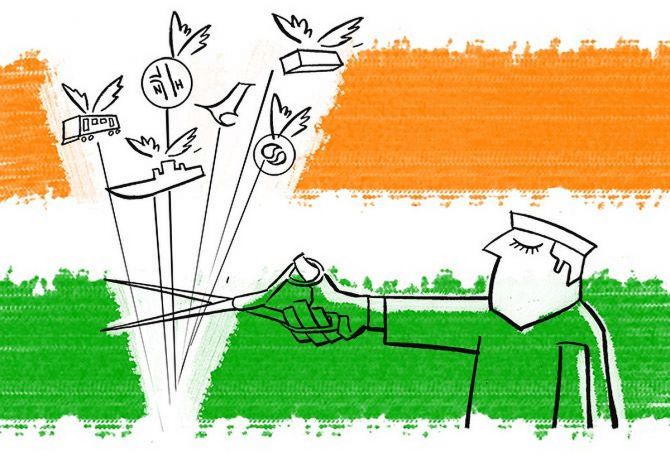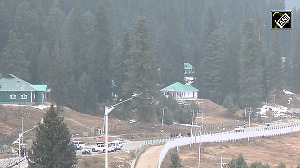Merely bringing down the government stake below 51% may not find any taker for the PSBs.
The government must bring down its holding to at least 26%, recommends Tamal Bandyopadhyay.

In a recent interview with Business Standard, Finance Minister Nirmala Sitharaman compared privatisation of banks and insurance companies with the Rath Yatra.
'So much effort goes in searching for a tree, then it is chopped, then it is brought with fanfare, and there are specific days when the wheel is made...,' she has said, referring to the arduous process that the government needs to go through for privatisation of public sector banks.
Let's extend the simile of Rath Yatra. This was the case in July 1969 when a set of private banks was nationalised. The Ulta Rath Yatra is the ritual that marks the end of the Rath Yatra as Lord Jagannath comes back to his home, the Jagannath Puri temple, after an eight-day stay at his aunt's house. In this case, the return journey is being made not after eight days, but 53 years (that is, if the privatisation of public sector banks happens this year).
All three deities -- Subhadra, Balabhadra and Jagannath -- return to the temple in the Ulta Rath Yatra. In case of banks, to start with, only two among 12 public sector banks (PSBs) will be privatised, besides IDBI Bank Ltd which has already been undergoing the process.
Fourteen banks with deposits of at least Rs 50 crore (Rs 500 million) each were nationalised on the midnight of July 19, 1969, hours after then prime minister Indira Gandhi's address to the nation.
A second round of nationalisation followed in 1980 -- of six more banks with deposits of more than Rs 200 crore (Rs 2 billion) each.
Since then, the banking industry has grown manifold. In June 1969, there were 73 commercial banks; now there are 78, excluding small finance banks and payments banks as well as regional rural banks and local area banks. The number of bank branches has grown from 8,262 to 211,332 between June 1969 and December 2021.
In June 1969, the deposit portfolio of banks was Rs 4,646 crore (Rs 46.46 billion) and the loan book Rs 3,599 crore (Rs 35,99 billion). By July 1, 2022, the deposit portfolio had grown to Rs 169.6 trillion and the loan book Rs 123.8 trillion.
Ahead of the privatisation plan, the government embarked on a consolidation drive to make the banks bigger and stronger. Following this, the number of PSBs has shrunk from 27 in 2017 to 12. Seven of them are fairly large and one, the State Bank of India, is among the top 50 banks by assets globally.
The February 2021 Union Budget, for the first time, spoke about privatising two PSBs. Even before that, the government had committed to privatise IDBI Bank. The Life Insurance Corporation of India acquired 51 per cent in IDBI Bank in January 2019. Since then, its stake has come down to 49.24 per cent, as the bank expanded its equity raising Rs 1,435 crore (Rs 14.35 billion) from qualified institutional investors in December 2020. The government owns 45.48 per cent in the bank.
IDBI Bank is a private bank, governed by the Companies Act, 2013. Despite that, it is not out of the clutches of the Central Vigilance Commission; it is also covered by the Right to Information Act; and, it needs to follow the rajbhasha norms -- the hallmark of PSBs.
LIC has committed to infuse capital for five years, if required, and dilute its stake to 40 per cent within 12 years. However, following the mandate of the Insurance Regulatory and Development Authority of India, LIC will reduce its stake in the bank below 15 per cent and cede management at the earliest.
An IDBI Bank team already held a roadshow in June in the US, showcasing it to prospective investors -- a bank with a Rs 3 trillion balance sheet which has made profit in the past two years; its net bad loans are 1.27 per cent of assets and provision coverage ratio is 97.6 per cent.
But things have not moved as the Department of Investment and Public Asset Management of the finance ministry has not yet invited the so-called expression of interest from the investors.
Traditionally, the government has been divesting its stake in public sector undertakings to make money but the logic behind privatisation of banks is to stop using public money as a lifeline. Since 1994, it has pumped in close to Rs 4.5 trillion in these banks as capital.
Besides, Prime Minister Narendra Modi has said that the government's job is to care for the poor, ensure food, toilets, houses, and supply of clean drinking water, but it has 'no business to be in business'.
To pave the path for privatisation, the Bank Nationalisation Act has to be amended. Will the government stop at bringing down its stake just below 51 per cent or pare it more? This is the key to the success of privatisation. There are many more changes that need to be done if the government wants to excite investors about the PSBs.
The Nationalisation Act confers sweeping controlling powers to the government, which are not available to any other major shareholders.
- For instance, the government can exercise voting rights above 10 per cent -- a privilege not available to any other shareholder [Section 3(2E)].
- It has a decisive role in the increase and decrease of capital [Section 3(2A) & (2B)].
- It can issue directions to the nationalised banks (Section 8) in the public interest. Technically, it needs to be done after consulting with the Reserve Bank of India but the Department of Financial Services, a finance ministry arm, does this often without keeping the banking regulator in the loop.
- The government has the power to appoint whole-time directors (including managing director), non-executive chairman and other members in the board of directors [Section 9(3)].
- It can supersede the board (Section 18A) and even sanction making of regulations (Section 19).
- The government has the power to liquidate any bank; and also, its nod is necessary for merger between two public sector banks.
In sum, the government enjoys more powers than a majority stakeholder in any board-run company. For PSBs, the government is the superboard, with both ownership and regulatory powers.
Merely bringing down the government stake below 51 per cent may not find any taker for the PSBs. If the government is ready to give up its powers, it must bring down its holding to at least 26 per cent.
Any serious investor will be willing to look at PSBs when it will have a say in the affairs of the bank with higher voting rights; it won't be fond of interference/intervention/control of the government while putting in dollops of money.
Finally, the tenure of the CEOs and EDs must be longer -- beyond 60 years. Currently, the CEO's age is capped at 70 years for the private banks. And the compensation must be market-linked.
In 2014, the P J Nayak Committee, set up to review governance of the boards of banks in India, made these recommendations. Eight years have passed but nothing has happened so far.
While celebrating the 53rd anniversary of bank nationalisation, the government must do some soul searching if it's serious about privatising a few PSBs.
Privatisation without ceding powers is like having the cake and eating it too.
Tamal Bandyopadhyay, a consulting editor with Business Standard, is an author and senior adviser to Jana Small Finance Bank Ltd.











